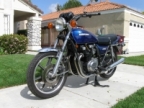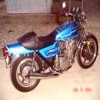Float adjustment question...
- Bluemeanie
-
 Topic Author
Topic Author
- Offline
- User
-

Registered
- Posts: 2516
- Thanks: 15
Float adjustment question...
29 Sep 2009 20:43
Brought my bike to work today and pulled the carbs for a float adjustment. I used my new spiffy tool (threaded brass with O ring and clear hose) from ebay and it works like a charm! Highly recommended for $8.95!! Found all my floats too high of course and adjusted them to spec. Bike seems to run a little smoother and has better throttle response. My question is.... I've looked at drawings of carbs and what I don't understand is how a carb can be too rich or lean with the level off. Isn't it just important that the jet be submerged? If the float level is too high, how is the extra fuel getting into the motor?
1980 KZ650F1, Bought new out the door for $2,162.98!
Attachments:
Please Log in or Create an account to join the conversation.
- chance
-

- Offline
- User
-

Registered
- Life long biker/
- Posts: 578
- Thanks: 0
Please Log in or Create an account to join the conversation.
- Patton
-

- Offline
- KZr Legend
-

Registered
- Posts: 18568
- Thanks: 2102
Re: Float adjustment question...
30 Sep 2009 04:33
The posted image of "float" system depicts fuel into bowl (including the overflow tube), but not fuel passage out of the bowl (such as starter system, pilot system and main system).
In this example, am thinking "main" system (not "float" system") whereby higher level on bleeder tube allows more fuel being sucked from needle jet opening as incoming air rushes past enroute to intake port.
Good Luck!
In this example, am thinking "main" system (not "float" system") whereby higher level on bleeder tube allows more fuel being sucked from needle jet opening as incoming air rushes past enroute to intake port.
Good Luck!
1973 Z1
KZ900 LTD
KZ900 LTD
Please Log in or Create an account to join the conversation.
- Bluemeanie
-
 Topic Author
Topic Author
- Offline
- User
-

Registered
- Posts: 2516
- Thanks: 15
Re: Float adjustment question...
30 Sep 2009 06:54 - 30 Sep 2009 06:54
I kinda thought it was something like that, was just curious. Thanks guys. Bike does run smoother and has better throttle response. Will see if milage increases too. Highly recommened this tool though for adjustment, way better than stuffing hose into opening! Works perfect.
1980 KZ650F1, Bought new out the door for $2,162.98!
Attachments:
Last edit: 30 Sep 2009 06:54 by Bluemeanie.
Please Log in or Create an account to join the conversation.
- TeK9iNe
-

- Offline
- User
-

Registered
- What did you do!?!
- Posts: 2436
- Thanks: 28
Re: Float adjustment question...
01 Oct 2009 08:33 - 01 Oct 2009 08:34
I know this! :laugh:
It all works based on volume. Not fuel height. Although that is the best way to get an acurate reading of the fuel volume in the bowl, becuase of float-stop deficencies.
The free air that reaches the bowl when the engine creates vacuum becomes higher pressure than the air in the carburetor venturi. Thus it applies a pulse of pressure on the volume of the fuel in the bowl. If the fuel volume is to big (high), the pressure pulse pushes more cfm's (volume) fuel into the venuri. A rich condition. Consequently the opposite when the fuel is too little (low). A lean condition.
Fuel volumes are super important!
Cheers!

It all works based on volume. Not fuel height. Although that is the best way to get an acurate reading of the fuel volume in the bowl, becuase of float-stop deficencies.
The free air that reaches the bowl when the engine creates vacuum becomes higher pressure than the air in the carburetor venturi. Thus it applies a pulse of pressure on the volume of the fuel in the bowl. If the fuel volume is to big (high), the pressure pulse pushes more cfm's (volume) fuel into the venuri. A rich condition. Consequently the opposite when the fuel is too little (low). A lean condition.
Fuel volumes are super important!
Cheers!
Motorcycle Shop Owner/Operator
79 Kawie Z1000 LTD
81 Kawie Z1000 CSR
83 Honda VT750C A
85 Kawie GPZ900 A2
86 Zukie GS1150 EG
93 Yamie XV1100 E
Lucky to have rolled many old bikes through my doors
79 Kawie Z1000 LTD
81 Kawie Z1000 CSR
83 Honda VT750C A
85 Kawie GPZ900 A2
86 Zukie GS1150 EG
93 Yamie XV1100 E
Lucky to have rolled many old bikes through my doors
Last edit: 01 Oct 2009 08:34 by TeK9iNe.
Please Log in or Create an account to join the conversation.
- savedrider
-

- Offline
- User
-

Registered
- 1975 Z1-B 900
- Posts: 476
- Thanks: 1
Re: Float adjustment question...
30 Oct 2009 21:33
Hey Bluemeanie, when you used this tool did you do it with the rack on the bike or did you do it on the bench?
Seems you would want to do it on the bench so you can make adjustments as needed right?
Guess I'm answering my own question now, but I was curious.
Seems you would want to do it on the bench so you can make adjustments as needed right?
Guess I'm answering my own question now, but I was curious.
Get right or get left! <*{{{><
Please Log in or Create an account to join the conversation.
- Patton
-

- Offline
- KZr Legend
-

Registered
- Posts: 18568
- Thanks: 2102
Re: Float adjustment question...
31 Oct 2009 03:46 - 31 Oct 2009 03:51
savedrider wrote:
TIP --- When removing and replacing the float bowls between float tang adjustments and observing fuel level inside the clear tube, only one float bowl screw is needed. Saves time and effort.
Good Luck!
Hey Bluemeanie, when you used this tool did you do it with the rack on the bike or did you do it on the bench?
Seems you would want to do it on the bench so you can make adjustments as needed right?
Guess I'm answering my own question now, but I was curious.
TIP --- When removing and replacing the float bowls between float tang adjustments and observing fuel level inside the clear tube, only one float bowl screw is needed. Saves time and effort.
Good Luck!
1973 Z1
KZ900 LTD
KZ900 LTD
Last edit: 31 Oct 2009 03:51 by Patton.
Please Log in or Create an account to join the conversation.
- HerrDeacon
-
- Offline
- User
-

Registered
- Posts: 642
- Thanks: 1
Re: Float adjustment question...
31 Oct 2009 04:02
TeK9iNe wrote:
Great explanation TeK9iNe, thanks for posting. I always wondered about it as well.
I know this! :laugh:
It all works based on volume. Not fuel height. Although that is the best way to get an acurate reading of the fuel volume in the bowl, becuase of float-stop deficencies.
The free air that reaches the bowl when the engine creates vacuum becomes higher pressure than the air in the carburetor venturi. Thus it applies a pulse of pressure on the volume of the fuel in the bowl. If the fuel volume is to big (high), the pressure pulse pushes more cfm's (volume) fuel into the venuri. A rich condition. Consequently the opposite when the fuel is too little (low). A lean condition.
Fuel volumes are super important!
Cheers!
Great explanation TeK9iNe, thanks for posting. I always wondered about it as well.
Please Log in or Create an account to join the conversation.
- Bluemeanie
-
 Topic Author
Topic Author
- Offline
- User
-

Registered
- Posts: 2516
- Thanks: 15
Re: Float adjustment question...
31 Oct 2009 05:40 - 31 Oct 2009 05:42
savedrider wrote:
Some guys have made a board with old carb holders then clamped it in a vice. I removed carbs and then gently clamped them in a vice making sure they were perfectly level. Used a Gator aid bottle (wide mouth) to catch gas when removing drain screw or tool. After adjusting all four carbs I simply poured gas (half a bottle) back in tank.
Hey Bluemeanie, when you used this tool did you do it with the rack on the bike or did you do it on the bench?
Seems you would want to do it on the bench so you can make adjustments as needed right?
Guess I'm answering my own question now, but I was curious.
Some guys have made a board with old carb holders then clamped it in a vice. I removed carbs and then gently clamped them in a vice making sure they were perfectly level. Used a Gator aid bottle (wide mouth) to catch gas when removing drain screw or tool. After adjusting all four carbs I simply poured gas (half a bottle) back in tank.
1980 KZ650F1, Bought new out the door for $2,162.98!
Last edit: 31 Oct 2009 05:42 by Bluemeanie.
Please Log in or Create an account to join the conversation.
- Patton
-

- Offline
- KZr Legend
-

Registered
- Posts: 18568
- Thanks: 2102
Re: Float adjustment question...
31 Oct 2009 06:08 - 31 Oct 2009 06:11
Think of when using a common drinking straw to suck liquid from a glass.
It's the normal air pressure pushing down against the surface of the liquid that pushes the liquid up through the straw toward the vacuum being created by suction at the other end.
Sucking harder creates more vacuum (less air pressure at the sucked end) whereby more liquid is pushed up through the straw.
Instead of sucking on the straw, air blown fast enough across end of the straw also creates a vacuum, whereby liquid is pushed up through the straw. Same principle involved.
Another way to look at movement of fuel from floatbowl to carb bore is from the standpoint of "venturi effect" as explained in the Sudco manual.
It's like the "suction" created by fast moving air across end of the straw.
The fuel inside the float bowl is vented to normal outside air pressure, and is supposed to stay that way. Just like the liquid refreshment in the glass.
When the engine isn't running, the same normal outside air pressure exists inside the carb bore, there's no venturi effect --- Like when not sucking on the straw.
When the engine is running, air movement through the carb bore creates a lower than normal air pressure (i.e., venturi effect), which "vacuum" draws fuel mixture up from the floatbowl through a brass tube that ends with a needle jet at bottom of the carb bore (through which needle jet the tapered jet needle moves up and down, whereby volume of fuel is metered by throttle position). In other words, normal air pressure constantly being exerted on the fuel inside the float bowl "pushes" fuel up through the main jet, brass tube, and needle jet. Like sucking on the straw.
Fuel level inside the float bowl determines how much fuel is drawn up through the brass tube (aka pickup tube or bleeder tube) via the venturi effect and thereby available at the needle jet for being drawn through the intake ports and valves into the combustion chamber. Too high causes too rich. Too low causes too lean.
Good Luck!
It's the normal air pressure pushing down against the surface of the liquid that pushes the liquid up through the straw toward the vacuum being created by suction at the other end.
Sucking harder creates more vacuum (less air pressure at the sucked end) whereby more liquid is pushed up through the straw.
Instead of sucking on the straw, air blown fast enough across end of the straw also creates a vacuum, whereby liquid is pushed up through the straw. Same principle involved.
Another way to look at movement of fuel from floatbowl to carb bore is from the standpoint of "venturi effect" as explained in the Sudco manual.
It's like the "suction" created by fast moving air across end of the straw.
The fuel inside the float bowl is vented to normal outside air pressure, and is supposed to stay that way. Just like the liquid refreshment in the glass.
When the engine isn't running, the same normal outside air pressure exists inside the carb bore, there's no venturi effect --- Like when not sucking on the straw.
When the engine is running, air movement through the carb bore creates a lower than normal air pressure (i.e., venturi effect), which "vacuum" draws fuel mixture up from the floatbowl through a brass tube that ends with a needle jet at bottom of the carb bore (through which needle jet the tapered jet needle moves up and down, whereby volume of fuel is metered by throttle position). In other words, normal air pressure constantly being exerted on the fuel inside the float bowl "pushes" fuel up through the main jet, brass tube, and needle jet. Like sucking on the straw.
Fuel level inside the float bowl determines how much fuel is drawn up through the brass tube (aka pickup tube or bleeder tube) via the venturi effect and thereby available at the needle jet for being drawn through the intake ports and valves into the combustion chamber. Too high causes too rich. Too low causes too lean.
Good Luck!
1973 Z1
KZ900 LTD
KZ900 LTD
Last edit: 31 Oct 2009 06:11 by Patton.
Please Log in or Create an account to join the conversation.
- newOld_kz1000
-

- Offline
- User
-

Registered
- FlimFlamFlibbityFlee !! BoonFryedShickaMuhZee !!
- Posts: 751
- Thanks: 20
Re: Float adjustment question...
31 Oct 2009 22:23
I cannot find that on eBay -- I searched eBay Motors for:
- float level gauge
- float gauge
- carburetor float guage
- Kawasaki float level gauge
and nothing.
I've been 'hit-or-missing'
my float adjustments and I really like that 'runs smoother with better throttle response' !! Sounds great.
Does anyone know where to find that item on eBay, or know of another source? thanks.
The Kawasaki kz1000 '77-'78 service manual calls out the 'special tool' part #57001-208 that looks very much like it. Betcha that costs megabucks from Kaw though!
- float level gauge
- float gauge
- carburetor float guage
- Kawasaki float level gauge
and nothing.
I've been 'hit-or-missing'
my float adjustments and I really like that 'runs smoother with better throttle response' !! Sounds great.
Does anyone know where to find that item on eBay, or know of another source? thanks.
The Kawasaki kz1000 '77-'78 service manual calls out the 'special tool' part #57001-208 that looks very much like it. Betcha that costs megabucks from Kaw though!
1978 kz1000 A2 with Kerker
1980 Z1 Classic with Kerker
1980 Z1 Classic with Kerker
Please Log in or Create an account to join the conversation.
- Bluemeanie
-
 Topic Author
Topic Author
- Offline
- User
-

Registered
- Posts: 2516
- Thanks: 15
Re: Float adjustment question...
01 Nov 2009 05:14
Here ya go...
carb float level tool
1980 KZ650F1, Bought new out the door for $2,162.98!
Please Log in or Create an account to join the conversation.
Moderators: Street Fighter LTD



